The United Nations has warned that civilian deaths and injuries in Afghanistan sharply increased in the first half of 2021, setting the war-ravaged country on course to witness the highest ever number of civilian casualties in a single year.
The U.N. Assistance Mission in Afghanistan in its mid-year report has documented nearly 5,200 civilian casualties, including 1,659 deaths, an astounding 47% spike compared with the same period in 2020.
The report noted that civilian casualties have escalated since May, when the United States and NATO allies officially began their military withdrawal and fighting intensified between Afghan government forces and Taliban insurgents across the country.
“The number of civilian casualties during May and June — 2,392 in total (783 killed and 1,609 injured) — was the highest for those months since UNAMA began its systematic documentation in 2009” UNAMA said in a statement.
The report lamented as “sickening” the fact that women, boys and girls made up close to half of all civilian casualties in the first six months of 2021.
It warned that “without a significant de-escalation in violence Afghanistan is on course for 2021 to witness the highest ever number of documented civilian casualties in a single year since UNAMA records began.”
The Taliban say recent battlefield gains have extended insurgent control to 85% of Afghanistan, a contested claim.
However, since foreign forces started pulling from the country about three months ago, the Taliban have nearly tripled the number of districts they control, from about 75 to now more than 220 of 407 Afghan districts, according to the Foundation for Defense of Democracies’ Long War Journal.
The advances have brought the insurgents close to the capital cities of all 34 Afghan provinces as well as the national capital, Kabul.
Critics noted that the UNAMA report has refuted the Taliban’s claims their territorial gains have largely been bloodless.
“The U.N. is gravely concerned that if intensive military action is undertaken in urban areas with high population densities, the consequences for Afghan civilians could be catastrophic,” the report warned.
While international troops are set to exit Afghanistan by end of August, slow-moving peace talks between the Taliban and the Afghan government have met with little success. Both sides accuse each other of blocking the progress.
UNAMA chief Deborah Lyons on Monday urged the warring sides to intensify their efforts at the negotiating table, saying the pursuit of a military solution to the conflict will only fuel the suffering of the Afghan people.
“I implore the Taliban and Afghan leaders to take heed of the conflict's grim and chilling trajectory and its devastating impact on civilians,” Lyons said.
“The report provides a clear warning that unprecedented numbers of Afghan civilians will perish and be maimed this year if the increasing violence is not stemmed,” she added.
UNAMA attributed 64% of the total civilian casualties to anti-government armed forces, saying 39% of them were caused by the Taliban. Islamic State militants caused 9% while the rest were blamed on undetermined anti-government elements.
Pro-Afghan government forces were responsible for 25% of civilian casualties, according to the report.
It attributed 11% of all civilian casualties to “crossfire” during ground engagements where the exact party responsible could not be determined and other incidents.
An Afghan military spokesman, Ajmal Omar Shinwari, rejected findings in the U.N. report that government forces were responsible for causing civilian casualties.
“(Afghan) security forces have retreated from many areas only to prevent civilian casualties,” Shinwari argued while speaking at a news conference in Kabul.
Taliban spokesman Zabihullah Mujahid rejected the UNAMA report, claiming nowhere in Afghanistan in the last six months had insurgents “deliberately targeted or carried out attacks that could have resulted in civilian casualties.”
Monday’s U.N. mid-year report is the first since 2009 that has not attributed a single Afghan civilian casualty to international forces.










